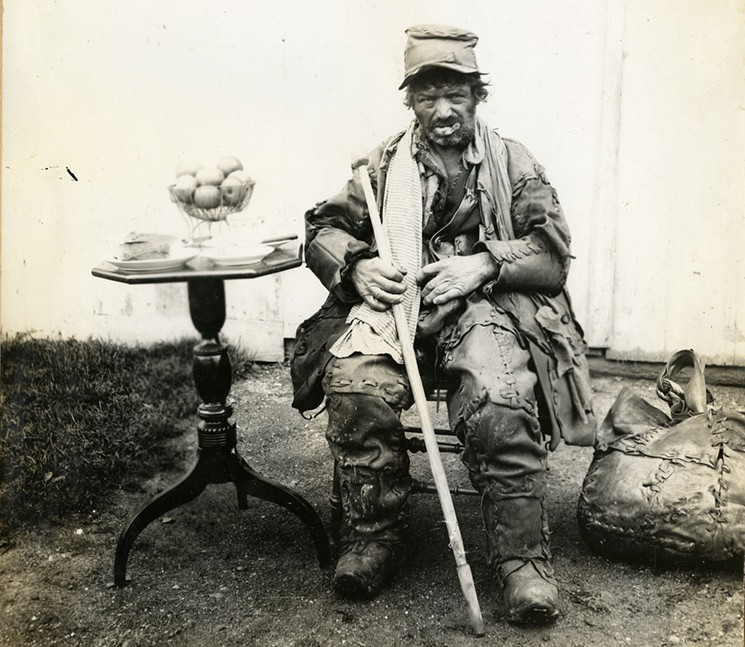The Old Leather Man
The Familiar Visitor
A century and a half ago, when our village was called Sing Sing, one of the 19th century’s most peculiar characters was rambling into legend. No one knew who he was, where he came from, or why he spent more than 30 years walking the back roads of New York and Connecticut, communicating primarily through grunts and hand gestures. But this “mysterious, eccentric pedestrian,” as The New York Times called him, became the subject of intense fascination, so much so that his death, in 1889, made the front page of the Gotham papers. In ways, the Leather Man was the American equivalent of another late 19th-century curiosity, England’s Elephant Man: eccentric, pitied and misunderstood.
What was most remarkable about the Leather Man—aside from his heavy, hand-made leather “suit” and wooden-soled shoes—was the systematic nature of his ramblings. For many years, he traveled the same 365-mile route, always on foot. After being harassed by hooligans who tried to force-feed him a bottle of whiskey, the Leather Man avoided densely populated areas. He walked clockwise, along the same roads, through the same villages, stopping at the same homes for food and sleeping in the same caves he’d found along the way. Each loop took 34 days to complete, but his schedule was so precise—he arrived within 30 minutes of the last time—that the villagers could almost set their watches by his impending arrival. How the Leather Man—who did not own a timepiece—kept to such a rigid schedule only added to the aura of mystery and fascination surrounding him.
Along the way, the Leather Man became a sort of one-man sideshow. Newspapers reported on his comings and goings. Children ran out to see him, both fascinated and repelled. He was photographed numerous times, and Victorian-era writers penned long, elaborate fictions about his life. A mythology grew up around him. He was said to be a Frenchman who had suffered a terrible tragedy and that his wanderings were his penance. He had been spurned by a beautiful woman in France and fled the country. He had been a wealthy businessman who lost the family fortune and gone insane. The truth is, all anyone knew for sure was that he was harmless.
After the great blizzard of 1888, the Leather Man’s health began to deteriorate, and the public became so concerned for his welfare that the Connecticut Humane Society arrested him and put him in a hospital, though he managed to escape and continue his ramblings, even as cancer ate away at his jaw.
One of the Leather Man’s caves in Westchester County was on the Mount Pleasant property of a farmer named George Dell and another was on the Ryder farm. In March of 1889, a carpenter named Henry Miller agreed to satisfy his wife’s desire to see the Leather Man’s cave. Upon arriving, they found the Leather Man himself, recently dead. The body was taken to Sing Sing, where the coroner concluded he died from mouth cancer, the result of tobacco use. Hundreds of people from miles around came to view his body at White & Dorsey’s undertaking rooms. He was buried in Sparta Cemetery next to the Highland Turnpike, now called Route 9. A life-size dummy, dressed in the leather suit—said to weigh 65 pounds—was displayed at a museum in New York and a carnival sideshow in Coney Island. It was ultimately lost to fire.
Over time, local historians decided on an identity for the Leather Man. In 1953, the Ossining Historical Society erected a bronze plaque next to Route 9 that read “Jules Bourglay from Lyons.” This identification was later discredited.
Meanwhile, the Leather Man’s legend grew. He was the subject of a 1984 documentary, “The Road Between Heaven and Hell” (it can be viewed on youtube.com). Several of his favorite caves are stops on “Leather Man Tours” and can be visited by the general public. The annual Leather Man’s Loop, a 10K cross-country race in northern Westchester, draws almost 1,000 runners. He has even entered the popular culture, inspiring a 1998 song by Pearl Jam. (“Once a month they’d spot him and here’s what they’d say./“Here he comes. He’s a man of the land. He’s leatherman./Smile on his face. Axe in his pack.”) In 2008, Wesleyan University Press published a book, The Old Leather Man, by Dan W. DeLuca, that is now in its sixth printing.
The Leather Man’s legend took another turn in the spring of 2011, when the board of the Ossining Historical Society Museum decided to exhume the Leather Man’s remains. They hoped, using DNA testing, to determine his home country and whether, as some theorized, he suffered from autism. While some believed his remains should be left undisturbed, the museum board felt that the grave, which received many visitors, deserved a safer location, away from the traffic of Route 9. Any remains, if found, would be reburied in a quieter section of the cemetery.
The Leather Man Project was lead by Dr. Nicholas Bellantoni, a world-renowned forensic archeologist who heads Connecticut’s Office of State Archaeology. For two days, he excavated the site thought to be the Leather Man’s final resting place. They only found coffin nails, in the outline of his coffin.
The nails and surrounding soil were relocated near the Sparta Cemetery flagpole. The old bronze plaque is on display at the Ossining Historical Society Museum. And the Old Leather Man continues to live on as the mystery he always was.
—Dana White





